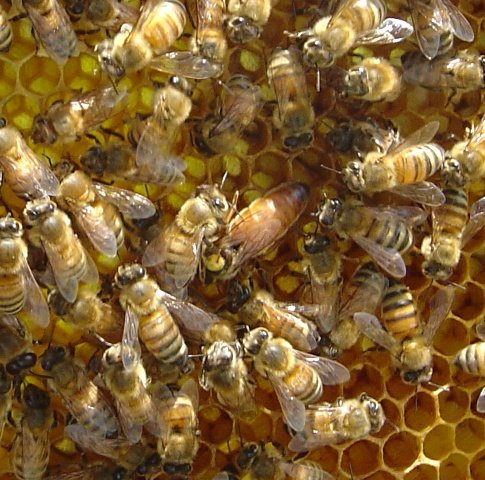It has been over a month since my last post.
During the last week of June I placed 13 queen cells into queen-less nuc hives. These queens, once emerged, would mate naturally and start to lay eggs in about 14 days and build new colonies.
Above: Four mating nucs ready for queen cell introduction.
The jars will be filled with sugar syrup to feed the nucs.
The main honey flow stopped a month early, and because we were feeding sugar syrup to the nuc colonies, robbing ensued. Many of the mating nucs and new queens were destroyed by strong colonies that came and killed bees while robbed them of their honey and syrup.
Only 3 mated queens survived.
Left: Virgin queens in queen cages. These queens are being taken care of by nurse bees. They have been placed in a queenbank colony.
As part of an experiment I had taken eight of the queen cells and arranged them so the virgin queens would emerge into queen cages. These cages were placed into a queen-less, brood-less hive. The queens emerged into the cages and were taken care of by the surrounding nurse bees. Because the virgin queens would be in the cages, they would not be able to mate.
Right: A closer view of the banked queens. A special frame with wire guides hold the cages in place. The plastic cell cup seals the top of the cage.
I have had some success over the past two years rising queens. One of my strongest hives this year is lead by a queen I produced last summer. She is the daughter of the queen from my strongest hive the previous year. I have noticed that the most uncontrollable part of queen rearing is the mating process.
Above: You can see the open queen cell inside the cage
as well as the queen. Nurse bees surround the queen and
feed here through the cage openings. I'm sure they are trying
to find a way to get her out!
It is all left to chance at that point.
Above Left: A screw lid jar is used to put the queen to sleep with carbon dioxcide. It only takes a few minutes
Above Right: CO2 is dispensed through water so the flow can be seen and regulated.
It is apparent that the week link, the place where you loose control, in the process is mating. So I started looking into the process of instrumental insemination of honey bees. With II the breeder can control the mating process and select the specific genetic material to mix with the genetics of the virgin queen.
Above: Insemination device I have been working on. CO2
is fed through a hose to keep the queen asleep.
Above: Working out the "bugs" in the system
Need smaller hooks and glass tips.
Left: This queen was put to sleep, placed in the instrument, manipulated, but not inseminated. She woke up about 15 minutes later.
Needless to say my first attempts have had some successes and many failors….
Right: Second queen was put to sleep, manipulated, and woke up. She was not inseminated.
But I have learned a lot.
I will share more in future posts.
.


































